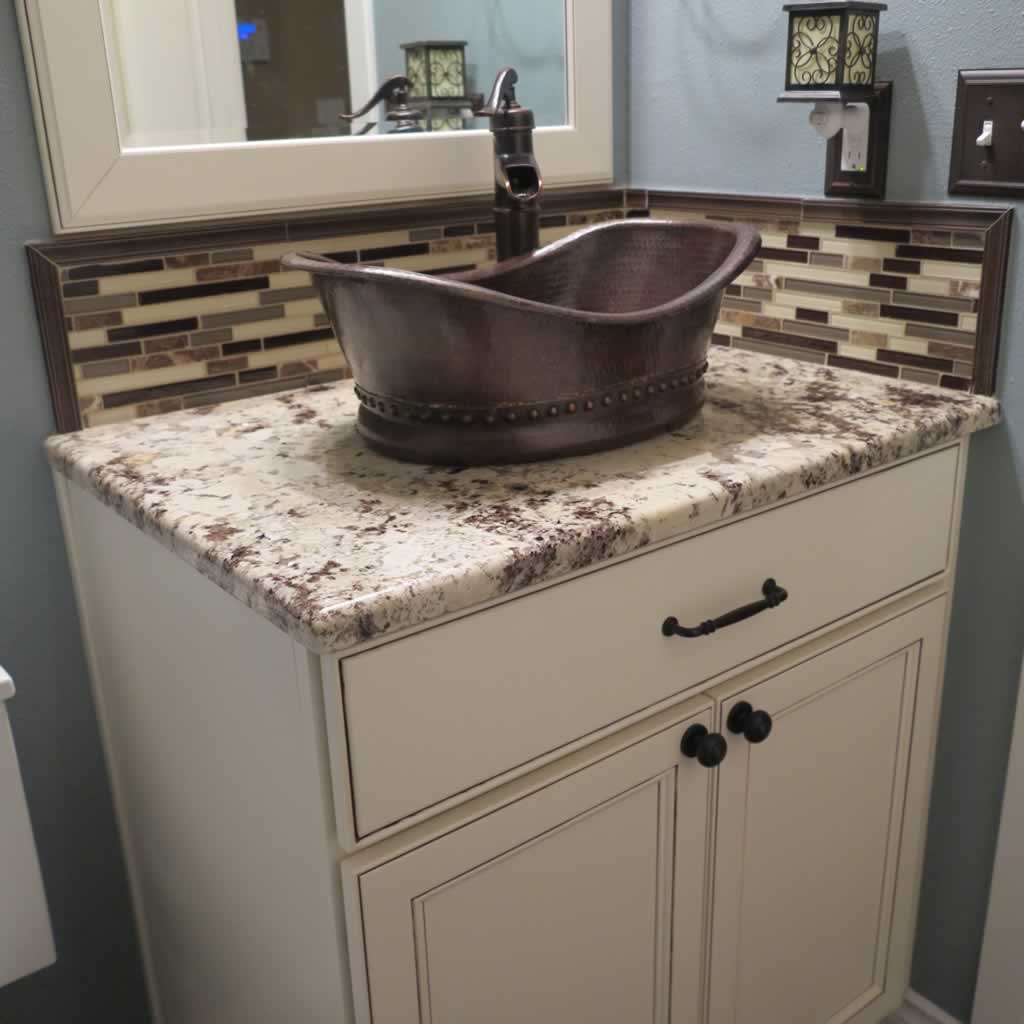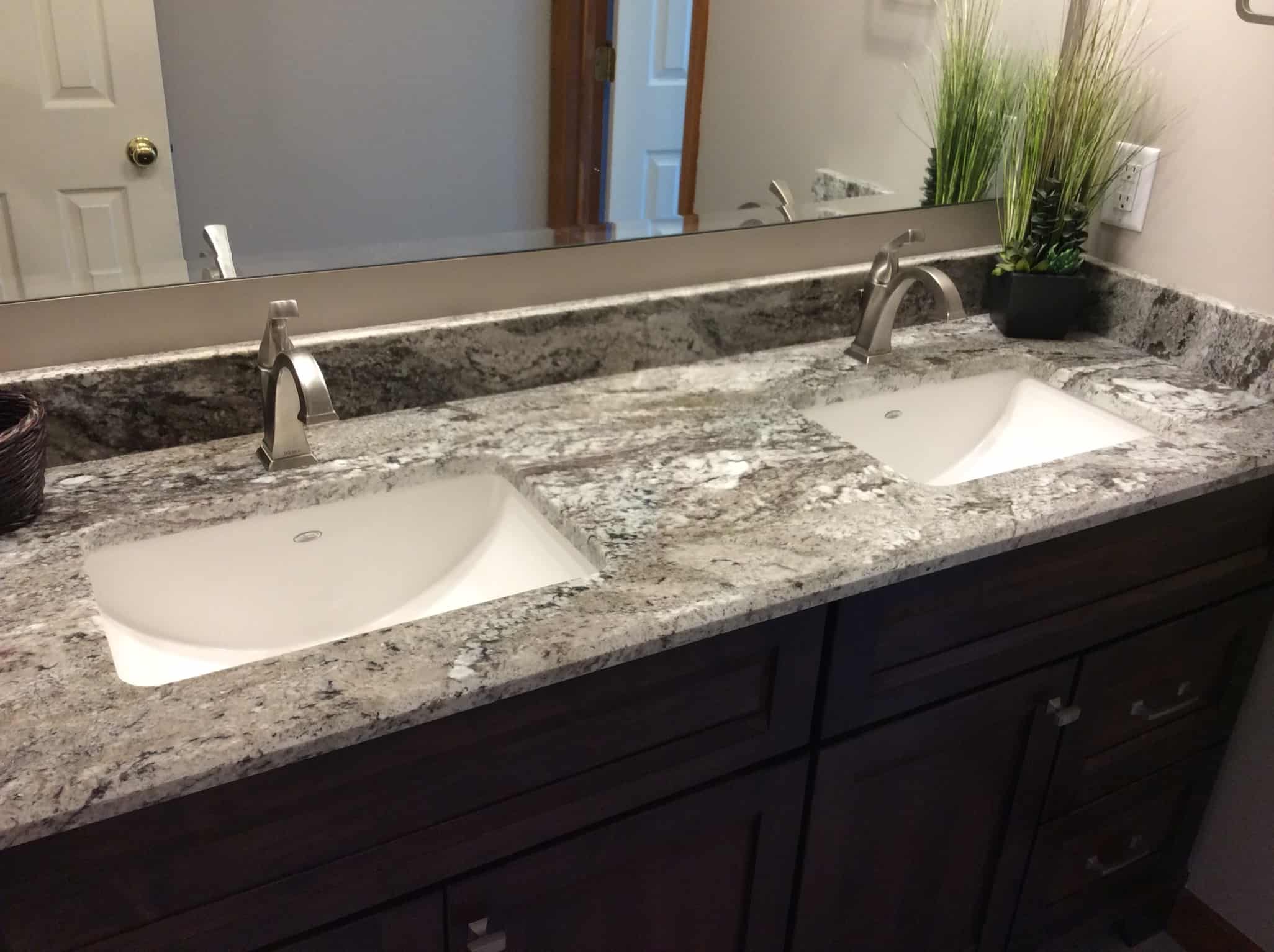Granite Countertop Benefits for Bathroom Vanities

Granite countertops are a popular choice for bathroom vanities due to their durability, beauty, and practicality. Granite is a natural stone that has been used for centuries in construction and design, and its unique properties make it an ideal material for bathroom countertops.
Durability and Longevity
Granite countertops are known for their exceptional durability and longevity. They are resistant to scratches, heat, and moisture, making them an excellent choice for a high-traffic area like a bathroom. Granite is also a very hard material, making it difficult to chip or crack. This means that granite countertops can withstand the wear and tear of everyday use, and they are likely to last for many years.
Resistance to Moisture, Heat, and Scratches
Granite is a naturally porous stone, but it is also very dense. This density makes it resistant to moisture and water damage. Granite countertops can withstand spills and splashes, and they are not susceptible to mold or mildew growth. Granite is also heat-resistant, making it safe to place hot items on the surface. The hardness of granite also makes it highly resistant to scratches, ensuring that your countertop will remain beautiful for years to come.
Natural Beauty and Unique Patterns
Granite is a natural stone, and each slab has its own unique patterns and colors. This natural variation makes granite countertops a beautiful and distinctive addition to any bathroom. The unique patterns and colors of granite can add a touch of elegance and sophistication to your bathroom, and they can be used to create a variety of different styles.
Choosing the Right Granite for Your Bathroom Vanity

The journey to finding the perfect granite for your bathroom vanity begins with understanding the diverse world of granite types and their unique qualities. Each variety possesses a distinct character, influencing its appearance, durability, and suitability for your bathroom’s aesthetic.
Granite Types and Their Characteristics
Granite is a natural stone formed from volcanic activity, offering a wide array of colors, patterns, and textures. Understanding the characteristics of different granite types can help you make an informed decision.
- Black Granite: Known for its elegance and sophistication, black granite is a popular choice for bathroom vanities. Its dark hues create a sense of drama and luxury, complementing modern and contemporary bathroom designs. Some common black granite varieties include Absolute Black, Black Galaxy, and Nero Assoluto.
- White Granite: White granite exudes a sense of purity and spaciousness, making it ideal for smaller bathrooms. Its bright color reflects light, creating a feeling of openness. Popular white granite varieties include Bianco Antico, Alaska White, and River White.
- Gray Granite: Gray granite offers a versatile option, blending seamlessly with various bathroom styles. Its subtle tones and subtle veining create a calming and sophisticated atmosphere. Some common gray granite varieties include Silver Shadow, Steel Gray, and Pietra Grey.
- Brown Granite: Brown granite brings warmth and richness to a bathroom. Its earthy tones create a cozy and inviting ambiance. Some popular brown granite varieties include Tan Brown, Golden Brown, and Kashmir White.
- Beige Granite: Beige granite offers a neutral backdrop, complementing a wide range of bathroom decor styles. Its warm and inviting tones create a sense of tranquility. Some popular beige granite varieties include Crema Marfil, Giallo Ornamental, and Jura Beige.
Installing Granite Countertops on a Bathroom Vanity: Granite Counter For Bathroom Vanity

Installing granite countertops on a bathroom vanity can seem daunting, but with the right tools, materials, and careful planning, it’s a project that many DIY enthusiasts can tackle. This section will guide you through the process, from preparation to sealing, ensuring a professional and seamless installation.
Preparing the Vanity
Before installing granite countertops, it’s crucial to prepare the vanity surface. This ensures a smooth and secure installation.
- Remove the Existing Countertop: Carefully remove the existing countertop, ensuring you don’t damage the vanity base.
- Clean the Surface: Thoroughly clean the vanity surface, removing any dirt, debris, or old adhesive residue.
- Check for Levelness: Ensure the vanity surface is level. If not, use shims to adjust the level.
Cutting the Granite
Cutting granite requires specialized tools and techniques.
- Measure and Mark: Carefully measure the vanity surface and mark the granite countertop for cutting.
- Use a Wet Saw: A wet saw is the preferred tool for cutting granite. It uses a diamond blade and water to cool the blade and prevent dust.
- Practice on Scraps: Before cutting the actual countertop, practice on scrap pieces of granite to get comfortable with the saw and cutting techniques.
Installing the Granite
Once the granite is cut, it’s time to install it on the vanity.
- Apply Adhesive: Apply a bead of construction adhesive along the edges of the vanity surface.
- Position the Countertop: Carefully position the granite countertop on the vanity, aligning it with the marked lines.
- Secure with Clamps: Use clamps to secure the countertop in place while the adhesive dries.
Sealing the Granite, Granite counter for bathroom vanity
Sealing granite is crucial to protect it from stains and water damage.
- Apply Sealant: Use a high-quality granite sealant, following the manufacturer’s instructions.
- Apply in Thin Coats: Apply the sealant in thin coats, allowing each coat to dry completely before applying the next.
- Repeat as Needed: Repeat the sealing process every 6-12 months, depending on the type of sealant used and the amount of traffic the countertop receives.
Tools and Materials
Here are the essential tools and materials needed for installing granite countertops:
- Wet Saw: For cutting granite precisely.
- Diamond Blade: For use in the wet saw.
- Measuring Tape: For accurate measurements.
- Marker: For marking the granite for cutting.
- Construction Adhesive: For bonding the granite to the vanity.
- Clamps: For securing the countertop in place.
- Granite Sealant: For protecting the granite from stains and water damage.
- Safety Glasses: For protecting your eyes from dust and debris.
- Gloves: For protecting your hands.
Granite counter for bathroom vanity – A granite countertop can really elevate the look of your bathroom vanity. If you’re going for a serene and sophisticated vibe, a blue and gray bathroom, like the ones featured in this article , would be a perfect match.
Granite comes in a variety of colors and patterns, so you can find the perfect shade to complement your blue and gray palette.
A granite counter for your bathroom vanity adds a touch of elegance and durability. To complement the luxurious feel, consider adding a wooden bathroom towel rail , which will bring warmth and natural beauty to the space. The combination of granite and wood creates a harmonious balance, making your bathroom feel both stylish and inviting.